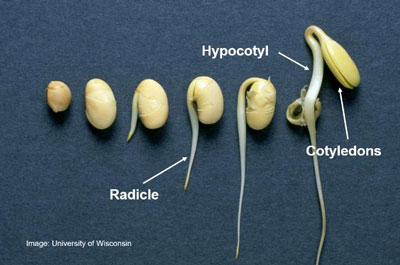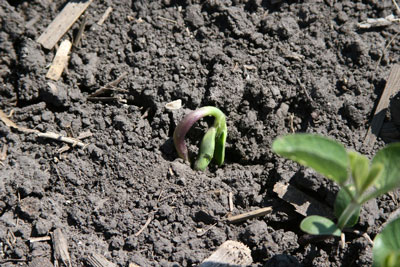
- The hypocotyl elongates to pull the cotyledons through the soil, once this occurs the soybeans have emerged and the growing point is above the soil surface.
- Keeping soybeans clean during the critical weed free period begins at V1 and ends around the V4 growth stage.
- Active nitrogen fixation starts to occur at V2, once nodules that are formed on the roots turn to a pinkish color in the inside.
When talking crop emergence, there is a tendency to compare the mesocotyl of the corn plant and the hypocotyl of the soybean plant. After all, they both play a role in getting the crop above ground. In corn, the lengthening mesocotyl pushes the coleoptile to the soil surface. In soybeans, the lengthening hypocotyl pulls the cotyledons and growing point to the soil surface. The top of the hypocotyl forms a bend or “arch” as it drags the cotyledons to the soil surface. Once the cotyledons are above the soil surface, the growing point is exposed and vulnerable to environmental stresses like hail, frost and pests. Loss of both cotyledons and their points of attachment will result in plant death. However, the loss of one cotyledon at this time will have little effect on yield, while the loss of both cotyledons, without harm to their points of attachment,will result in 2-7% yield loss. These points of attachment will become the new growing points of the plant. If an insect or pathogen attacks the hypocotyl arch, or if the soil is compacted, the arch may break. When this happens, the soybean will stop growing and die. If the hypocotyl itself is damaged by pest feeding, disease infection, or mechanical injury, the whole emergence process can come to a halt and the soybean seedling will die.
Under favorable growing conditions, the hypocotyl (with its arch at the top) drags the cotyledons and growing point upward until the hypocotyl arch is exposed to sunlight. When light hits the hypocotyl arch, the arch straightens and lifts the cotyledons and growing point free of the soil surface. Continuing cell division results in further stem growth and node development, with the cotyledon node followed by the unifoliate node, followed by the first trifoliate node. The cotyledon and unifoliate nodes are at opposite sides of the stem. The first, and subsequent, trifoliate nodes are all in an alternate side arrangement on the stem.
Once soybeans enter the V1 growth stage, one fully expanded trifoliate, the critical weed free period begins. Prior to this point, the cotyledons have provided nutritional needs for the plant. Weed competition during the critical weed free period results in rapid, irreversible yield loss. Grassy weeds impact yield losses much less than broadleaf weeds. Published research indicates that for every day that soybeans have to compete with weeds, yield losses can range from 0.5 to 2 bushels per acre. The critical weed free period generally ends around the V4 growth stage, but can extend further under heavy weed infestations.
Soybeans start to actively fix nitrogen at the V2 growth stage; when plants have two fully expanded trifoliates. Fixation of atmospheric nitrogen to plant available nitrogen is due to soybeans having a symbiotic relationship with Bradyrhizobia japonicum, a soil-bacterium. Nodule formation begins shortly after emergence and continues through about R5.5 growth stage. Nodules form best when soil moisture content is 50% of field capacity or less and require good soil aeration. Actual active fixation doesn’t begin until the nodules are a coral (pink) color on the inside.
Soybeans grow rather fast once the soybeans start fixing nitrogen, so being at a specific growth stage doesn’t last very long. On average a new trifoliate is expanded every 3-5 days.
Image: Soybean Germination & Anatomy
Image Below: Hypocotyl Arch Beginning to Straighten & Lift Cotyledons
